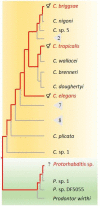Reproductive Span of Caenorhabditis Elegans is Extended by Microbacterium Sp
- PMID: 35860519
- PMCID: PMC9260829
- DOI: 10.2478/jofnem-2022-0010
Reproductive Span of Caenorhabditis Elegans is Extended by Microbacterium Sp
Abstract
The reproductive span (RS) of organisms could be affected by different factors during their lifetime. In the model nematode, Caenorhabditis elegans, RS is affected by both genetic and environmental factors. However, none of the factors identified so far were related to environmental bacteria, which may incidentally appear anywhere in the habitats of C. elegans. We aimed to find environmental bacteria that could affect the RS of C. elegans and related species. We tested 109 bacterial isolates and found that Microbacterium sp. CFBb37 increased the RS and lifespan of C. elegans but reduced its brood size. We studied the effect of M. sp. CFBb37 on the RS of Caenorhabditis briggsae, Caenorhabditis tropicalis, and another Rhabditidae family species, Protorhabditis sp., and found similar trends of RS extension in all three cases, suggesting that this bacterial species may induce the extension of RS broadly among Caenorhabditis species and possibly for many other Rhabditidae. This work will facilitate future research on the mechanism underlying the bacterial extension of RS of nematodes and possibly other animals.
Keywords: Caenorhabditis nematodes; Microbacterium sp.; Protorhabditis sp.; bacteria; brood size; lifespan; physiology; reproductive span.
© 2022 Tho Son Le et al., published by Sciendo.
Figures





Similar articles
-
REPRODUCTIVE ISOLATION IN RHABDITIDAE (NEMATODA: SECERNENTEA); MECHANISMS THAT ISOLATE SIX SPECIES OF THREE GENERA.Evolution. 1992 Jun;46(3):585-594. doi: 10.1111/j.1558-5646.1992.tb02067.x. Evolution. 1992. PMID: 28568672
-
Bacterial Respiration and Growth Rates Affect the Feeding Preferences, Brood Size and Lifespan of Caenorhabditis elegans.PLoS One. 2015 Jul 29;10(7):e0134401. doi: 10.1371/journal.pone.0134401. eCollection 2015. PLoS One. 2015. PMID: 26222828 Free PMC article.
-
Description of Caenorhabditis sinica sp. n. (Nematoda: Rhabditidae), a nematode species used in comparative biology for C. elegans.PLoS One. 2014 Nov 6;9(11):e110957. doi: 10.1371/journal.pone.0110957. eCollection 2014. PLoS One. 2014. PMID: 25375770 Free PMC article.
-
Comparative genomics in C. elegans, C. briggsae, and other Caenorhabditis species.Methods Mol Biol. 2006;351:13-29. doi: 10.1385/1-59745-151-7:13. Methods Mol Biol. 2006. PMID: 16988423 Review.
-
[Genetics and evolution of developmental plasticity in the nematode C. elegans: Environmental induction of the dauer stage].Biol Aujourdhui. 2020;214(1-2):45-53. doi: 10.1051/jbio/2020006. Epub 2020 Aug 10. Biol Aujourdhui. 2020. PMID: 32773029 Review. French.
Cited by
-
Germline mitotic quiescence and cell death are induced in Caenorhabditis elegans by exposure to pathogenic Pseudomonas aeruginosa.Genetics. 2024 Jan 3;226(1):iyad197. doi: 10.1093/genetics/iyad197. Genetics. 2024. PMID: 37956057 Free PMC article.
-
Thousands of Pristionchus pacificus orphan genes were integrated into developmental networks that respond to diverse environmental microbiota.PLoS Genet. 2023 Jul 3;19(7):e1010832. doi: 10.1371/journal.pgen.1010832. eCollection 2023 Jul. PLoS Genet. 2023. PMID: 37399201 Free PMC article.
References
-
- Angelo G., Van Gilst M. R.. Starvation protects germline stem cells and extends reproductive longevity in C. elegans. Science. 2009;326:954–958. - PubMed
-
- Clark L. C., Hodgkin J.. Commensals, probiotics and pathogens in the caenorhabditis elegans model. Cell Microbiol. 2014;16:27–38. - PubMed
-
- Croll N. A., Smith J. M., Zuckerman B. M.. The aging process of the nematode caenorhabditis elegans in bacterial and axenic culture. Experimental Aging Research. 1977;3:175–189. - PubMed
LinkOut - more resources
Full Text Sources
